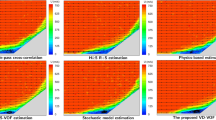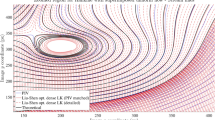Abstract
We present an approach to particle image velocimetry based on optical flow estimation subject to physical constraints. Admissible flow fields are restricted to vector fields satifying the Stokes equation. The latter equation includes control variables that allow to control the optical flow so as to fit to the apparent velocities of particles in a given image pair. We show that when the real unknown flow observed through image measurements conforms to the physical assumption underlying the Stokes equation, the control variables allow for a physical interpretation in terms of pressure distribution and forces acting on the fluid. Although this physical interpretation is lost if the assumptions do not hold, our approach still allows for reliably estimating more general and highly non-rigid flows from image pairs and is able to outperform cross-correlation based techniques.





















Similar content being viewed by others
Notes
Without loss of generality we take Δx = Δy = 1.
Note that we confine ourselves to the time-independent case as we want to analyze image pairs only and therefore have no additional information about the temporal evolution of the velocity.
Note that due to the regularizer, we will still get reliable velocity estimates at these locations.
This is only true when solving the problem with the Stokes equation. If we had used the Navier–Stokes equations, the pressure distribution would read \({\frac{\partial p} {\partial r}} = {\frac{\sigma v^2}{r}}.\)
We assume that the (imaginary) grid in out-of-plane direction has the same resolution as the in-plane grid.
References
Braess D (1997) Finite elements. Theory, fast solver, and applications in solid mechanics. Springer, Berlin Heidelberg New York
Brezzi F, Fortin M (1991) Mixed and hybrid finite element methods. Springer-Verlag New York, Inc., New York
Carlier J, Heitz D (2005) 2D turbulence sequence provided by Cemagref within the European Project ‘Fluid Image Analysis and Description’. http://fluid.irisa.fr/
Corpetti Th, Heitz D, Arroyo G, Mémin E, Santa-Cruz A (2005) Fluid experimental flow estimation based on an optical-flow scheme. Exp Fluids 40(1):80–97
Elsinga GE, Scarano F, Wieneke B, van Oudheusden BW (2005) Tomographic particle image velocimetry. In: Proceedings of the 6th international symposium on particle image velocimetry (PIV’05), Pasadena, September 21–23
Gunzburger M (2002) Perspectives in flow control and optimization. Society for Industrial and Applied Mathematics, Philadelphia
Hackbusch W (1993) Iterative solution of large sparse systems of equations, vol 95 of Applied Mathematical Sciences. Springer, Berlin Heidelberg New York
Hain R, Kähler CJ (2005) Advanced evaluation of time-resolved PIV image sequences. In: Proceedings of the 6th international symposium on particle image velocimetry, Pasadena, September 21–23
Hain R, Kähler CJ (2005) Fundamentals in multiframe PIV. Exp Fluids (submitted)
Horn B, Schunck B (1981) Determining optical flow. Artif Intell 17:185–203
Jullien MC, Castiglione P, Tabeling P (2001) Intermittency of a passive tracer in the inverse energy cascade. Phys Rev E 64(3):035301
Kaga A, Yamaguchi K, Kondo A, Inoue Y (1998) Combination of PIV data with cfd using cost function method. In: Proceedings of the 8th international symposium on flow visualization, p 257
Kohlberger T, Mémin E, Schnörr C (2003) Variational dense motion estimation using the helmholtz decomposition. In: Griffin LD, Lillholm M (eds) Scale space methods in computer vision. LNCS, vol 2695. Springer, Berlin Heidelberg New York, pp 432–448
Landau LD, Lifschitz EM (1952) Hydrodynamik. Number 6 in Lehrbuch der theoretischen Physik. Verlag Harri Deutsch, Thun, 5. (1991) edition
LaVision (2005) DaVis. Software for Intelligent Imaging
Lions JL (1971) Optimal control of systems governed by partial differential equations. Springer, Berlin Heidelberg New York
Michaewicz Z (1994) Genetic algorithms + data structures = evolution programs. Springer, Berlin Heidelberg New York
Nagel HH, Enkelmann W (1986) An investigation of smoothness constraints for the estimation of displacement vector fields from image sequences. IEEE Trans Pattern Mach Intell 8(5):565–593
Nobach H, Ouellette NT, Bodenschatz E, Tropea C (2005) Full-field correlation-based image processing for PIV. In: Proceedings of the 6th international symposium on particle image velocimetry, Pasadena, September 21–23
Nobach H, Tropea C (2005) Improvements to PIV image analysis by recognizing velocity gradients. Exp Fluids 39:614–622
Ogawara K, Noborizato T, Iida S (1997) A moving least square PIV algorithm coupled with Navier–Stokes flow solver. In: Proceedings of the 2nd international Workshop on PIV’97
Okamoto K, Nishio S, Kobayashi T (2000) Standard images for particle-image velocimetry. Meas Sci Technol 11:685–691
Okuno T, Yasuhiko S, Nishio S (2000) Image measurement of flow field using physics-based dynamic model. Meas Sci Technol 11:667–676
Ruhnau P, Gütter C, Schnörr C (2005a) A variational approach for particle tracking velocimetry. Meas Sci Technol 16(7):1449–1458
Ruhnau P, Kohlberger T, Nobach H, Schnörr C (2005b) Variational optical flow estimation for particle image velocimetry. Exp Fluids 38:21–32
Schnörr C (1991) Determining optical flow for irregular domains by minimizing quadratic functionals of a certain class. Int J Comput Vis 6(1):25–38
Suter D (1994) Mixed-finite element based motion estimation. Innov Tech Biol Med 15(3):292–307
Yuan J, Ruhnau P, Mémin E, Schnörr C (2005) Discrete orthogonal decomposition and variational fluid flow estimation. In: Proceedings of the 5th international conference on scale space and PDE methods in computer vision, vol 3459, pp 267–278
Acknowledgments
The authors thank Johan Carlier (Cemagref) for providing the turbulent image pairs and Rainer Hain (TU Braunschweig) for providing the cross-correlation estimates. Support by the Deutsche Forschungsgemeinschaft (DFG, SCHN 457/6) within the priority programme “Bildgebende Messverfahren in der Strömungsmechanik” ( www.spp1147.tu-berlin.de ) and by the EU project “Fluid Image Analysis and Description” ( http://www.//fluid.irisa.fr/ ) is gratefully acknowledged.
Author information
Authors and Affiliations
Corresponding author
Rights and permissions
About this article
Cite this article
Ruhnau, P., Schnörr, C. Optical Stokes flow estimation: an imaging-based control approach. Exp Fluids 42, 61–78 (2007). https://doi.org/10.1007/s00348-006-0220-z
Received:
Revised:
Accepted:
Published:
Issue Date:
DOI: https://doi.org/10.1007/s00348-006-0220-z




